Content
The medicinal properties of meadow chamomile can be used in the treatment of acute and chronic diseases. The simple herb has significant health benefits and few side effects.
What it looks like and where it grows
Common lemongrass, or meadow chamomile (Leucanthemum vulgare), is a plant from the Aster family up to 80 cm tall. It is also often found under the name of a popovnik. It has a taproot up to 10 cm, growing obliquely, with numerous and longer lateral processes. The stems of the plant are straight, glabrous or slightly pubescent, without branching. The leaves of the common sycamore are arranged in the next order, in shape they are wedge-shaped in the upper part and oblong at the base of the shoot.
In the first year of life, the plant gives only a leaf rosette closer to autumn, and the next season it forms flower stalks. The buds are collected in single baskets up to 6 cm in diameter at the tops of the stems, are divided into two types - white long marginal and yellow tubular median. The fruits of the common daisy appear from August to October and are achenes with a one-sided crown.

The herb is widespread in the temperate climate of Eurasia; it can be found in North America, Australia and New Zealand. On the territory of Russia, it grows in Siberia, in the Central region, in the Caucasus and in the Crimea. Usually chooses meadows and slopes, forest glades, settles as a weed in fields and gardens.
Chemical composition
The medicinal properties and contraindications of meadow chamomile are determined by its internal composition. The leaves, stems and roots of the plant contain:
- flavonoids and antioxidants;
- coumarins;
- alkaloids;
- tannins;
- inulin;
- vitamin C;
- carotene;
- essential oils;
- hydroxycinnamic acids;
- fixed oils.
Herbal medicines have good firming and anti-inflammatory properties.
Why is meadow chamomile useful?
The common daisy is recommended for use in many diseases. The medicinal plant has a positive effect on the body, namely:
- fights inflammation and infections;
- improves the condition with laryngitis, bronchitis, pneumonia and tuberculosis;
- accelerates the movement of bile and stimulates the liver;
- has an analgesic effect;
- lowers blood pressure and strengthens blood vessels;
- cleans the blood of cholesterol and helps to remove toxins;
- reduces sugar levels and normalizes metabolic processes;
- improves the state of the nervous system and helps fight stress;
- has a beneficial effect on the heart.
Outwardly, remedies based on the common daisy are used to treat wounds, cuts and burns.Meadow chamomile relieves inflammation in dermatitis, promotes rapid tissue repair and prevents infection.
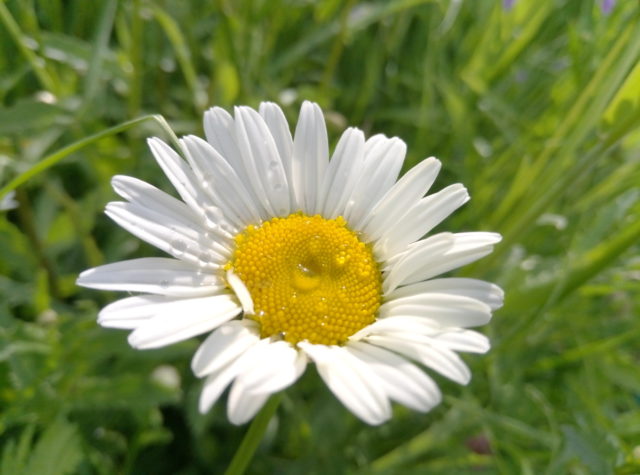
The benefits of meadow chamomile tea
The indications for using meadow chamomile tea are very wide. The drink is consumed:
- with cystitis and genitourinary infections;
- with pyelonephritis;
- with sluggish digestion and frequent alcohol consumption;
- with cardiovascular ailments;
- with hypertension;
- with stress and depression;
- with diabetes mellitus.
Nivyan tea is rarely harmful and tastes good. Therefore, you can use it in moderate dosages on a regular basis. The drink is used for preventive liver cleansing, after severe poisoning, as well as for the restoration of the gastrointestinal tract against the background of the use of drugs.
Preparation and application methods
Traditional medicine proposes to prepare water and alcohol preparations from an ordinary daisy. Both types of products have pronounced medicinal properties and are suitable for internal and external use.
Tea
To strengthen the immune system, for colds and inflammatory processes, tea from daisy becomes a universal medicine. Prepare it like this:
- Measure out a large spoonful of dried flowers, leaves and stems.
- Pour raw materials with 250 ml of hot water.
- Leave under the lid to infuse for 15-20 minutes.
- Filter the drink from the sediment.
Take the remedy up to three times a day between meals. The benefits and harms of meadow chamomile tea are preserved when honey is added to the drink, but it is undesirable to add sugar to it.
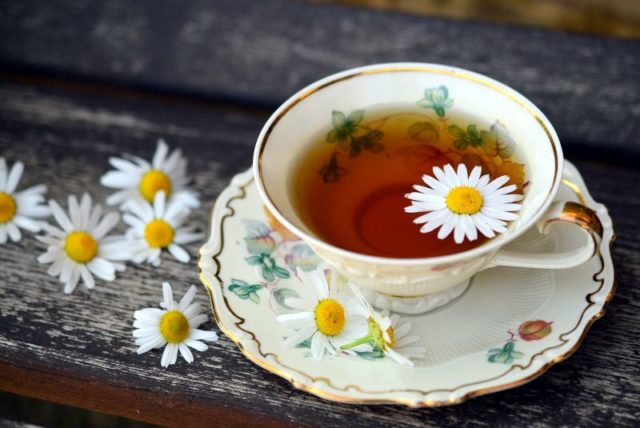
Infusion
For pain in the stomach, intestinal spasms and nervous disorders, traditional medicine recommends taking an infusion of common daisy. The drug is prepared according to the following algorithm:
- Pour 10 g of dry grass of the plant into a thermos, along with crushed inflorescences.
- Brew with a glass of boiling water.
- Close the lid and leave for four hours to infuse.
- After a lapse of time, filter.
It is necessary to consume an infusion of an ordinary sycamore plant four times a day, 15 ml. Take the remedy half an hour before meals or a couple of hours after it.
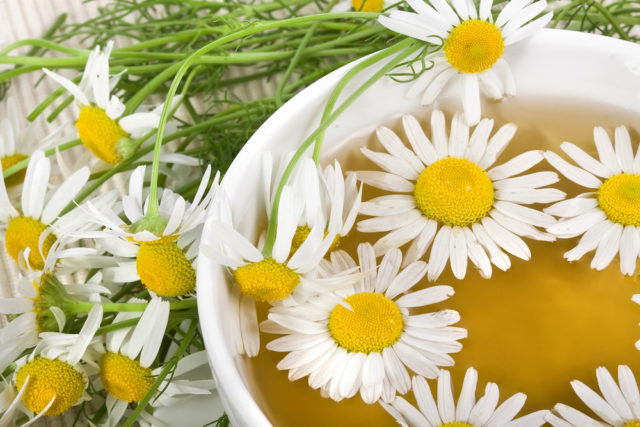
Tincture
A strong tincture of common cornflower is beneficial for colds and fever, helps with intestinal parasites and hernias. Prepare the drug according to this recipe:
- Mix in equal proportions crushed leaves of meadow chamomile and young nettle.
- Measure out a glass of the resulting raw material and pour 250 ml of good vodka.
- Seal the vessel and shake well.
- For two weeks they are removed in a cool, dark place.
The ready-made tincture of the common cornflower must be filtered. Take 30 drops of it in a large spoonful of clean water three times a day.
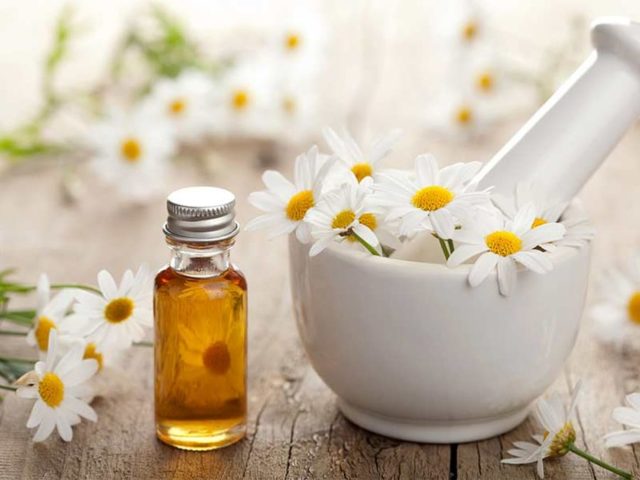
Ointment
For skin inflammations and injuries, you can use homemade ointment from an ordinary dyke. They do it like this:
- Dry stems, flowers and leaves of the plant are ground into powder.
- Measure 100 g of raw materials and combine with butter in equal proportions.
- Heat the product until warm and mix until completely homogeneous.
- Put in the refrigerator for solidification.
Ointment from the common cornflower is treated with cuts, healing burns, ulcers and irritations. The remedy is beneficial, including for lichen and eczema.
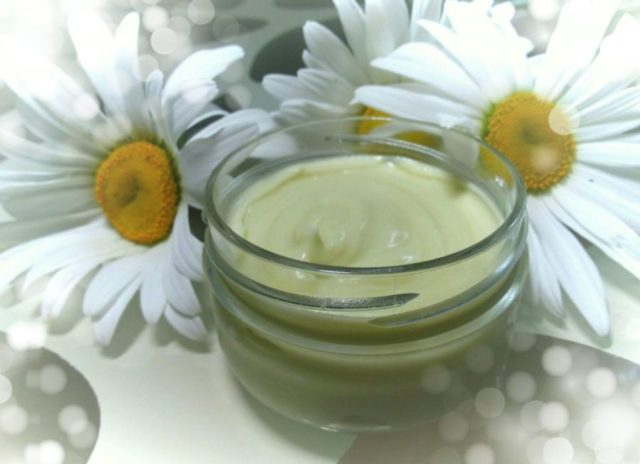
Application in traditional medicine
The medicinal properties of the common daisy are widely used in home health recipes.Traditional medicine uses the plant for digestive and inflammatory ailments, for spasms and skin diseases.
With hemorrhoids
A decoction of common sycamore relieves inflammation in hemorrhoids and helps stop bleeding. Prepare the tool like this:
- Dry flowers of the daisy are crushed in the volume of five large spoons.
- Pour raw materials with 500 ml of water.
- Heat over low heat for eight minutes after boiling.
- Cool under the lid and filter.
Warm broth can be added to sitz baths and used to lotion to the anus. It is best to combine both methods of treatment, then the remedy will give a quick effect.
With intestinal cramps
The common daisy relaxes smooth muscles and has an analgesic effect. For intestinal spasms, use the following infusion:
- Pour two small spoons of dried flowers of meadow chamomile into a glass.
- Pour 200 ml of hot liquid.
- Cover and leave for half an hour.
- Filter at the end of the term.
You need to drink the infusion of the daisy in half a glass up to four times a day.
With amenorrhea in women
The common daisy has a good effect with minor, but constant disruptions to menstruation in women. For gentle normalization of the cycle, use the following infusion:
- About 20 g of dry leaves of the plant are poured with a glass of boiling water.
- It is kept closed for half an hour.
- Pass through cheesecloth.
You need to drink an infusion of the common dyke during the day, a single dosage is 80 ml. The total course of treatment is continued for two weeks.
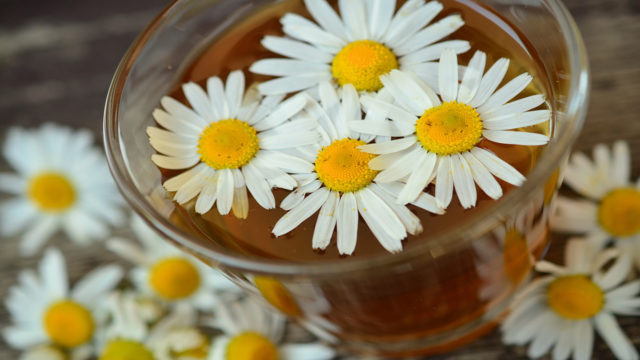
With a fever
The valuable properties of the common daisy help relieve high fever caused by colds or inflammation. The drug is prepared as follows:
- Pour 10 g of dry grass into a glass container.
- Pour 250 ml of hot liquid.
- Cover with a lid and wrap with towels.
- Leave for four hours and then filter.
You need to take an infusion of an ordinary sycamore in a large spoon up to four times a day. The course lasts a week.
With ischemia
The common daisy improves cardiovascular activity and prevents the development of complications in ischemia. For treatment, the following infusion is made:
- Grind and fall asleep in a thermos 15 g of dry rosehip berries.
- Add the same amount of meadow chamomile grass.
- Pour the components with 500 ml of boiling water.
- Close the thermos and leave it overnight.
The strained infusion of sycamore is taken 50 ml four times a day on an empty stomach. In total, therapy continues for three weeks.
With tonsillitis
The common daisy effectively relieves inflammation and fights bacteria in chronic tonsillitis. Traditional medicine advises to prepare an infusion for rinsing:
- Dry grass is crushed in the volume of a large spoon.
- Brew 300 ml of boiling water.
- Leave under the lid for an hour.
- Strain through folded gauze.
The throat is treated with infusion three times a day for a week. Before use, the product should be warmed to a warm state.
When depriving
The anti-inflammatory and healing properties of the common sapling are beneficial in the treatment of lichen. A solution for external use is made as follows:
- Pour 400 ml of boiling water over the grass and flowers of the plant in the amount of three large spoons.
- Place the product in a water bath and simmer for 20 minutes.
- Remove from the stove and leave under the lid for two hours.
- Pass through a gauze filter.
Use a solution of the common daisy for wiping the skin and lotions. It is recommended to continue treatment for two weeks, until the condition of the epidermis becomes noticeably better.
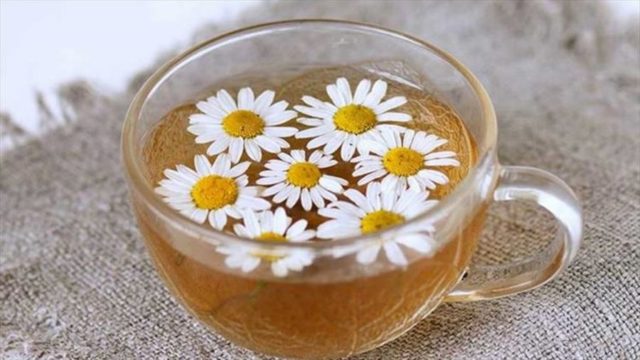
Application in cosmetology
The beneficial properties of meadow chamomile are used in the cosmetic field. First of all, plants rinse the hair with infusions and decoctions after washing. The common daisy accelerates the recovery of brittle and split ends, makes them smoother and more manageable, and stimulates the growth of strands. Regular use of the plant is indicated for increased fat content of the scalp and dandruff - meadow chamomile normalizes the activity of the sebaceous glands.
You can use an ordinary daisy for washing. Decoctions and infusions have a good effect on rashes, cleanse pores and help get rid of unpleasant oily sheen. In addition, meadow chamomile has a whitening effect and reduces the appearance of age spots.
Contraindications
A useful common daisy in some cases can harm the body. You cannot use it:
- under reduced pressure;
- during pregnancy and lactation;
- with acute pancreatitis;
- with severe heart and liver diseases;
- with a stomach ulcer in a state of exacerbation;
- with individual allergies.
In general, the daisy is considered a fairly safe plant. But it is still necessary to use it in accordance with the recipes. In excessive quantities, meadow chamomile can cause allergic reactions and intestinal disorders.
Collection and procurement
It is necessary to harvest the leaves, flowers and stems of the common cornflower during the decorative period of the plant - from mid-summer to autumn. With a sharpened garden tool, the shoots are cut at a distance of 10 cm from the ground surface, and then washed from contamination.
Medicinal raw materials must be spread in a thin layer on a baking sheet under a canopy and left until the moisture evaporates. In cold weather, the preparation is carried out at home in a warm room with good ventilation. Ovens and dehydrators can be used to process the common daisy, but the temperature should not exceed 50 ° C.
Dry raw materials of a medicinal plant are poured into paper bags or fabric bags and put into a cabinet with a low humidity level.
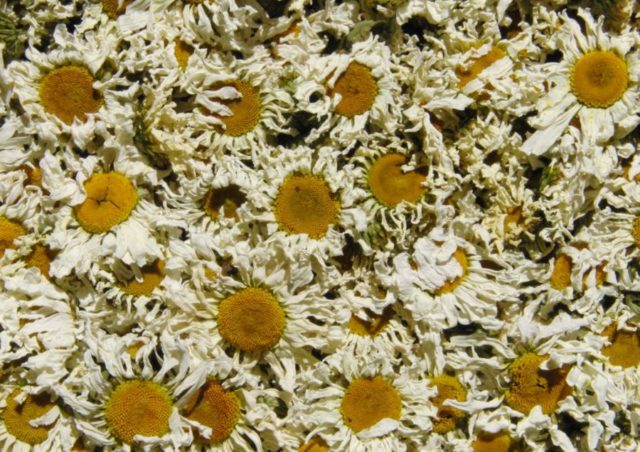
Conclusion
The healing properties of meadow chamomile have a beneficial effect on the digestive system, blood vessels and skin condition. A medicinal plant is used for the treatment of diseases and for prevention, but at the same time, dosages and rules for safe intake must be taken into account.

